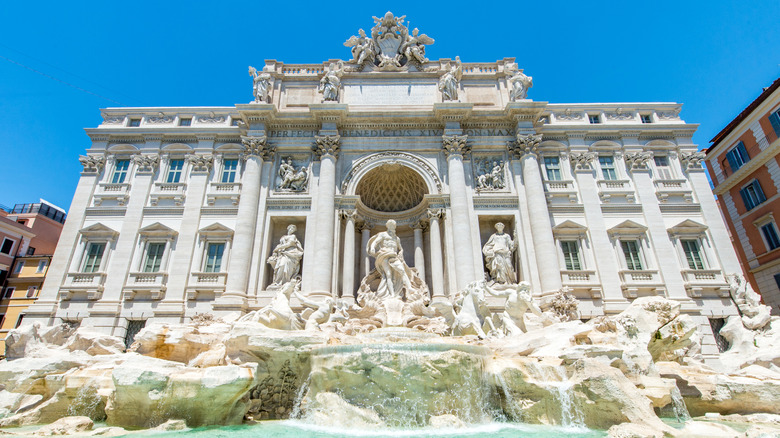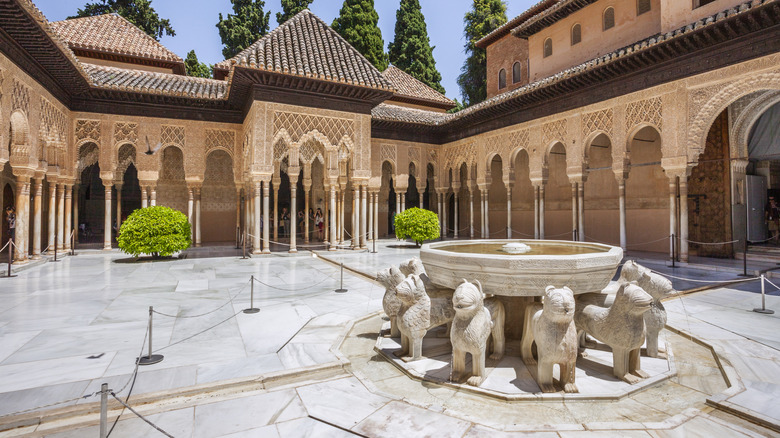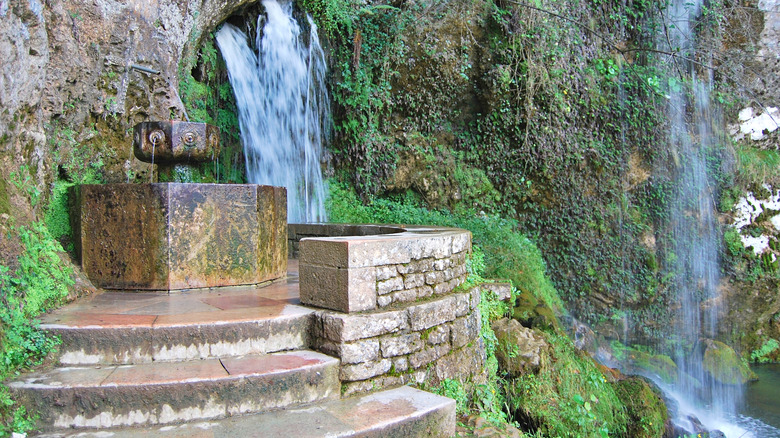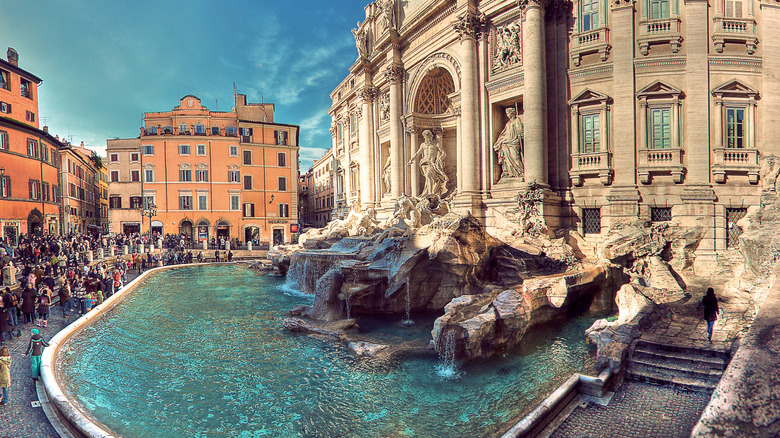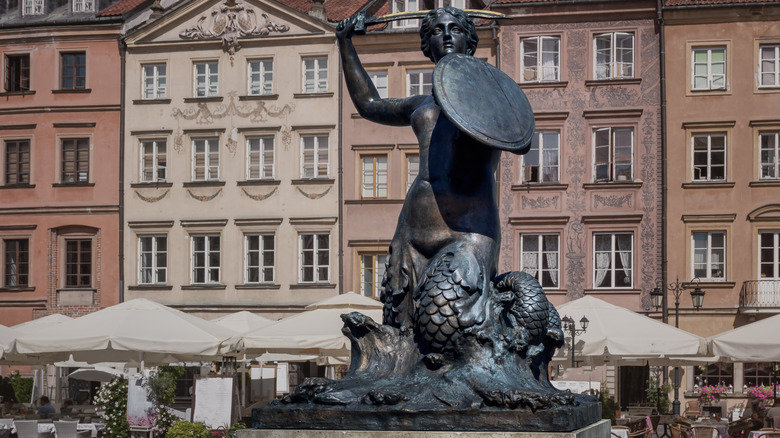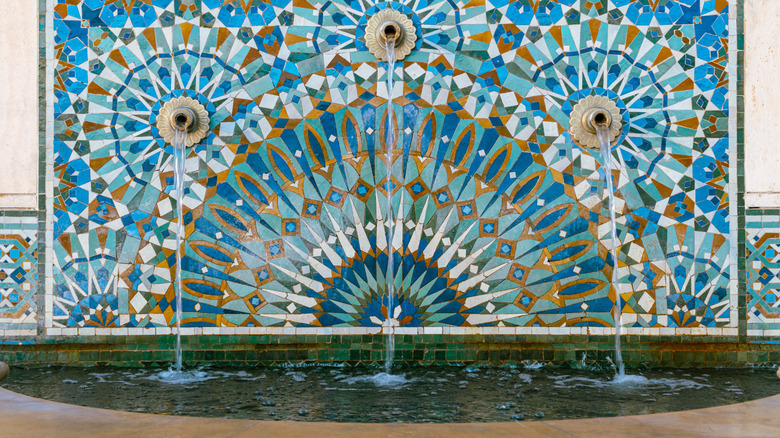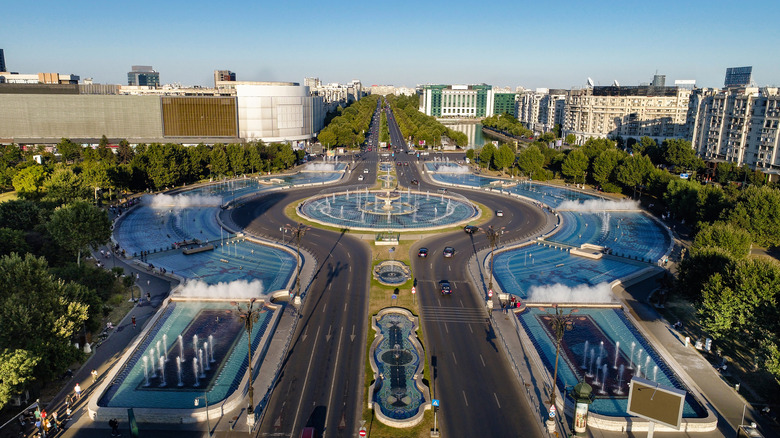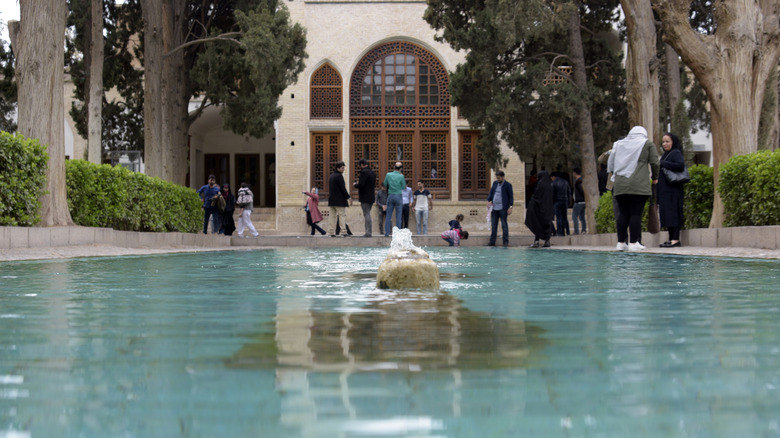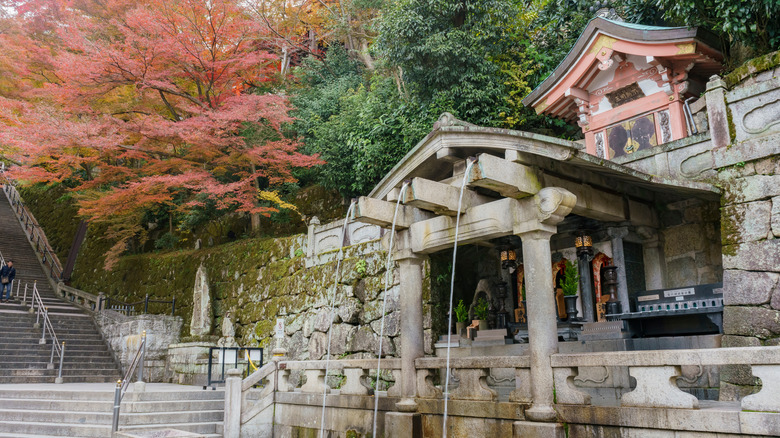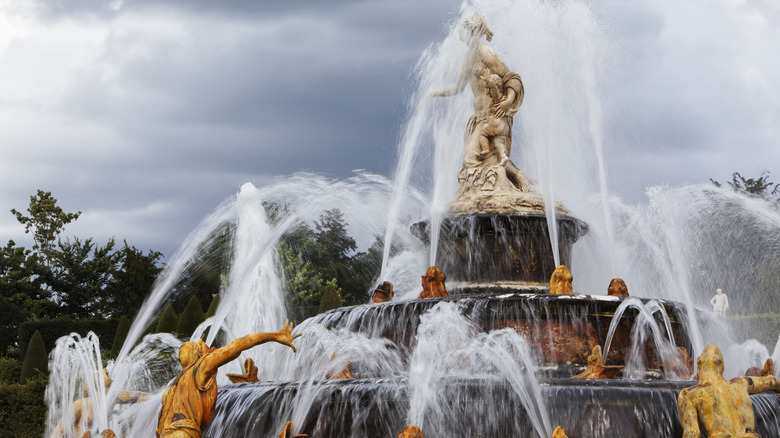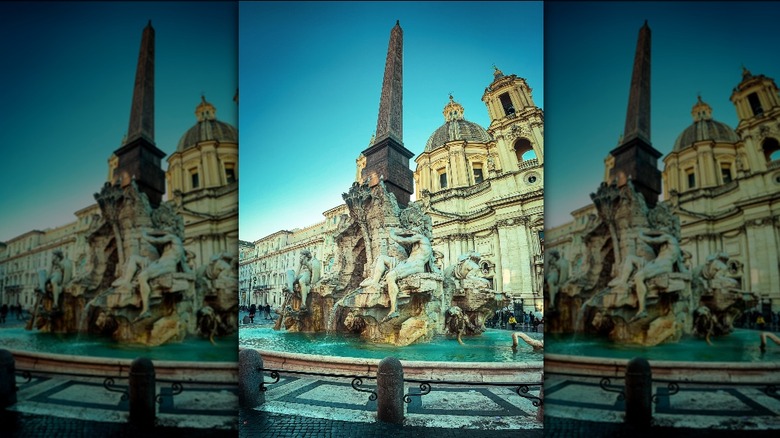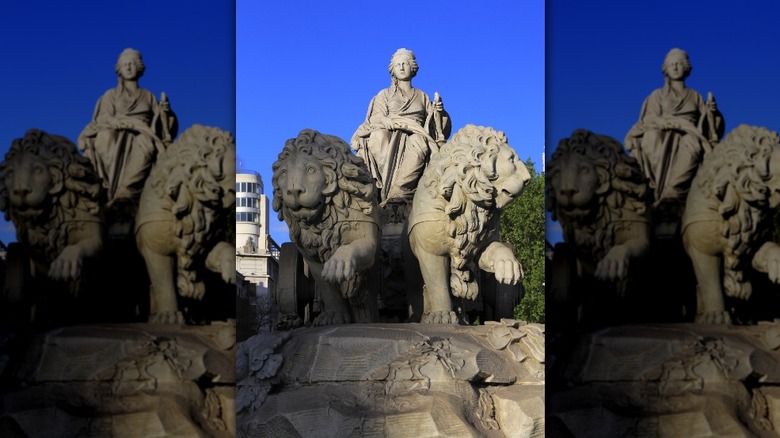11 Fountains Around The World That Are Legit Works Of Art
For some reason, humans really love fountains. Think of the fascination children have with spraying fonts or people's tendency to relax to the gentle sound of running water. Perhaps it is because they have provided clean drinking water — the sustenance for life. It is thus no surprise that artists and urban architects have made fountains a centerpiece of city life, elevating them to masterpieces of art and architecture that provide a cool drink and relief from the stresses of life.
What makes a fountain a work of art? People have argued over this one, and in many cases, it comes down to "you know it when you see it." There are tons of aesthetically beautiful fountains worldwide created by talented artists and architects. However, true masterpieces are those that, apart from immediately visible material beauty, also contain the artistic equivalent of subtext — rich cultural symbolism, storytelling, and harmonization with their surroundings. Whether being a representation of an Islamic paradise, telling the stories of Greco-Roman lore, or elevating the city of Rome to the center of the world, here are 11 artistic, aquatic masterpieces you won't want to miss.
Alhambra Patio de los Leones (Granada, Spain)
The city of Granada was once the crown jewel of Islamic Spain, thanks in no small part to the Alhambra Palace Complex. Built between the 13th and 14th centuries as a testament to Granada's high culture and wealth, the palace-fortress hosts all sorts of beautiful art, from tile work and incised epigraphic wall reliefs to numerous fountains that together create the image of a Moorish paradise straight out of the pages of Washington Irving's "Tales of the Alhambra." The palace's centerpiece is the Lion Patio, whose Lion Fountain tops the list as a masterwork of Islamic sculpture.
The fountain features 12 lions, each with a water spout coming out of its mouth, below a larger basin with a spout at the top. It sits in the middle of a marble courtyard surrounded by Moorish arches decorated with incised geometric reliefs. But in the time of Granadan Sultan Muhammad V (late 14th century), it was even more impressive. Andalusi poet Ibn Zamrak asked a rhetorical question in a poem etched on the outer rim of the basin: "[are] not in this garden wonders that God has made incomparable in their beauty..." From this poem, whose later lines explicitly reference the Lion Patio and the fountain, rather than the complex as a whole, one can infer that the Lion Fountain sat in the middle of a lush garden resembling an oasis of paradise. Right now, if you think it looks impressive with its shades of white and brown, think of how it looked when it was surrounded by greenery and colorful flowers.
Fuente de los Siete Caños (Covadonga, Spain)
The Fountain of the Seven Spouts, found in the Spanish Marian sanctuary of Covadonga in the northern region of Asturias, is easy to miss. For visitors, the main attractions are the cave church dedicated to the Virgin Mary and the massive basilica that rises out from behind the crags. The fountain, meanwhile, is nestled at the bottom of the cliff directly below the cave church.
The fountain is fed by a natural spring that flows from inside the mountain of Auseva itself. The main font consists of a hole in the mountain around which is built a cross resembling the Asturian Cross of Victory — the cross the Virgin Mary ordered Asturias' first king, Don Pelayo, to fashion before he went to battle against his Muslim enemies. This stream flows into a bowl-shaped basin, which channels the water into seven fonts and into the pool below the cliff. Next to it are several waterfalls also supplied by natural mountain water against a lush backdrop of mountain vegetation.
Because of the place and the fountain's Marian connections, the water is said to be imbued with mystical powers, including the ability to heal sickness and physical injuries and ailments and get women husbands. Local legend states that any woman who drinks out of all seven fonts while holding her breath the whole time will get married within the year. For this reason, it is also known as "the Wedding Fountain."
Fontana di Trevi (Rome, Italy)
If there's a big kahuna of world fountains, this is it. Measuring 86 feet high by 161 feet across, the Trevi Fountain is an enduring symbol of the Roman Baroque and prelude to the 18th-century neoclassical movement, when Greco-Roman styles roared back into vogue among Europe's elite. The fountain features sculptures of the god Oceanus riding a seahorse-pulled chariot accompanied by tritons — divine mermen of Greco-Roman lore. Adding to the material beauty is the fountain's symbolism. Pope Clement purposely chose the intersection of three Roman roads to evoke comparisons with classical antiquity. It was further connected to Rome's aqueduct said to supply the purest water, turning the fountain into a symbol of health and abundance — both of which are anthropomorphized as Greco-Roman divinities.
The fountain has a funny story behind its construction that was more akin to a government contract bidding war. Clement offered Italy's top talent a chance to pitch him designs for the Trevi Fountain. After all was said and done, the pope awarded the job to Alessandro Galilei. There was just one problem – Galilei was from Florence. The proud Roman public thought it insulting that a foreigner (Italy did not exist yet) should get the job when Rome had a perfectly capable native son in architect Nicola Salvi. In the end, Roman pride won out, and Salvi got the job. He worked on the fountain until his death in 1751, leaving Giuseppe Panini to finish it 11 years later. Going solely off the final product, it seems the pope made the right choice.
The Syrenka (Warsaw, Poland)
Warsaw's old city center hosts a simple fountain known in Polish as the "Syrenka" — literally, "the Little Mermaid." She serves as the city's mascot and is emblazoned on the city's coat of arms. The statue features a mermaid holding a shield and a sword — the opposite of what one might expect after watching Disney's "The Little Mermaid." While this fountain may not match the grandeur of the Trevi Fountain, its story propels it to a spot on this list — a story Americans might recognize from Disney or its antecedent, Danish writer Hans Christian Anderson's novel of the same name.
The story behind the Syrenka stretches back to time immemorial. Once, a king named Baltyk ruled the Baltic Sea from an underwater amber palace alongside his mermaid daughter. Out of curiosity, she swam to the mouth of the Vistula River and ended up near the site of modern Warsaw. There, a prince of the Mazovian tribe fell in love with her.
Unlike the Disney version, there is no happily ever after in the Polish tale. Instead, the syrenka told the prince, who was on a hunting trip, to visit the house of a peasant named Warsz and his wife. Despite being poor, the couple generously offered the prince the little they had. Impressed by their generosity, the prince accepted Warsz's invitation to live with them, uprooting his tribe to a new settlement built around the peasant couple's house. He named it Warszawa in honor of the generous peasant man. Today, the mermaid is a huge symbol of Warsawian popular culture, used in everything from political causes to walk/don't walk signs.
The 41 fountains of the Hassan II Mosque (Casablanda, Morocco)
Fountains are a central part of Islamic art and Moroccan culture, thanks to their associations with Islamic conceptions of heaven and their use for performing ablutions (ritual washing) before prayers. But unlike their European counterparts, Islamic law circumscribed Moroccan fountains' designs with prohibitions on human pictorial representation. Thus, artists from North Africa developed a style of tilework known as "Zellij" – the use of small shapes to make complicated geometric designs, chessboard-style floors, and even floral patterns known as "Arabesques." The style crystallized with the importation of Andalusi Muslim craftsmen from Spain and is today synonymous with Moroccan art.
Zellij is ubiquitous in Moroccan fountains in gardens, mosques, and homes — particularly in the old cities like Fes, Marrakech, and Meknes. The fountains of the Hassan II Mosque in Casablanca, however, take the cake for beauty and symbolism. Islamic fountains and the gardens they grace are meant to recreate Paradise. According to the mosque's own website, the mosque is situated on the Atlantic Ocean in remembrance of a Quranic verse that God's throne sits upon water. Surrounding God is Paradise, which consists of a massive public garden with 41 fountains decorated with Zellij tilework. When strolling through the grounds, visitors will be greeted with an explosion of turquoise, green, blue, white, brown, and black, complete with the calming sound of flowing water. Throw in the incised walls and Moorish architectural backdrop, and you've got yourself a place that, albeit not Paradise, seems pretty close.
Unirii Square (Bucharest, Romania)
When it comes to design, communism is better known for drab Soviet-style apartment blocks than artistic work of beauty. But Unirii Square in the Romanian capital, Bucharest, (also called "Little Paris of the East") is one of a small handful of exceptions. This fountain, which is really a system of at least 13, is more modern in design, consisting of a central fountain whose interior tilework resembles that of a compass or the sun. In the middle is a three-tier centerpiece, while around the arc of the basin are smaller fonts that all shoot inward. To the east and west of the fountain are four smaller basins. Around the central "eye" of the plaza are 12 smaller basins, all with their own fountains and their own tilework. Altogether, seen from above, they look like an eye, with the smaller fountains forming the socket and the central one forming the iris and pupil.
It's hard to compare Unirii to the Trevi or the Versailles fountain since they are so different. The latter two are more traditionally beautiful thanks to their sculpture, while the Unirii's beauty comes from what it can do – water-and-light shows. Imagine all the fonts of the at least 13 fountains in the square, all shooting off in choreographed succession the rhythm of classical, pop, and rock music. Throw in the lighting effects using the entire color spectrum, and you'll feel like you're watching the Fourth of July fireworks but with water.
Bagh-e Fin (Kashan, Iran)
Persian gardens are, in themselves, true works of art, and their fountains are no exception, not just for their aesthetics but also for their placement in the greater landscape. In Iranian culture, water represents purity and life, making fountains, pools, and canals indispensable features of the Iranian garden.
Take Bagh-e Fin. This garden, located near the city of Kashan and built under Safavid ruler Abbas II, is considered the Persian garden par excellence, hosting numerous fountains that, together with the surroundings, turn the garden into an Island of rest and relaxation. The Bagh-e Fin is an explosion of color. It is composed of gorgeous arched pavilions whose walls include stained glass in blue, red, and yellow and pathways lined with colorful flowers. The fountains supply the garden with water, which flows through a series of turquoise-colored pools and canals that reflect the plants and buildings surrounding them.
Bagh-e Fin's case is what in Persian is referred to as a "paradise garden" — a walled-off garden that provides a lush, green refuge from the hustle and bustle of city life. In this garden's case, the fountains' impotence is key. The city of Kashan is in the middle of the desert, and it gets quite hot. Thus, the fountains of Bagh-e Fin are supposed to be representative of an oasis — that life-sustaining pool in the middle of an otherwise inhospitable wasteland.
Otowa Falls (Kyoto, Japan)
Japan's concept of beauty is very different from that of the Western world. Instead of grand sculptures a la Trevi or Versailles, Japan's Shinto-Buddhist-inspired aesthetics highlights beauty, simplicity, and harmonization with natural surroundings. You see this in Japanese gardens and in their fountains, which, in their modesty, harmonize with their natural surroundings to create the visual of an unspoiled country retreat.
In Kyoto, Japan's old imperial capital, is the Kiyomizu-Dera Temple, a Buddhist temple and monastery that, according to its own website, is centered around the pure, unadulterated springs of Mt. Otowa, which provides a constant supply of fresh water. In the middle of it all is the Otowa Waterfall. This work of art consists of a roofed structure built into the cliff surrounded by verdant forests. At the top are three fonts that provide gentle streams of water – not rushing waterfalls as the name might at first suggest.
Once again, the beauty of this fountain comes from its placement, not necessarily just from its material aesthetic. Situated on the forested slopes of Mt. Otowa, the monastery's scenery is constantly changing. In spring, there is a burst of blooms in new life. In the summer, it's all green. In the fall, it is an explosion of red and yellow. In the winter, it's covered in pure, white snow. It is no surprise that this pure spring located against such a backdrop is believed to be imbued with special powers to grant wishes to those who drink a ladleful of water from each font.
Latona Fountain (Versailles, France)
The Château de Versailles represents the pinnacle of the French Bourbon dynasty, constructed under Louis XIV — the Sun King — in 1631. The palace and gardens were expanded in the following decades to include numerous fountains, canals, and ponds. One of the grander fountains, a five-tier masterpiece dating to 1668 with a statue of the goddess Latona (Leto in Greek) alongside Apollo and Artemis — her children. More confusing, however, is the presence of a bunch of contorted people and 24 frogs arranged in circles around the tiers. Each frog and person is a water spout that faces both inward and outward.
So what are these gods, people, and frogs all about? It turns out that the Versailles Latona fountain tells the story of Latona and the Lycian peasants from Ovid's "Metamorphoses," among others. According to this tradition, Latona arrived in Lycia (southern Turkey) in the dead of summer after giving birth to the twin gods Apollo and Artemis. Parched under the summer sun, she stopped to drink from a spring, but local Lycian peasants barred her access. After they refused to take pity on her and her children, they added injury to insult by throwing mud at her. She begged her husband Jupiter for revenge, and he obliged, changing the Lycians into frogs and condemning them to live in the mud they had slung at Latona.
Fontana dei Quattro Fiumi (Rome, Italy)
Apart from churches, Rome is full of fountains, most of which were built to provide a clean source of drinking water to the population through old Roman aqueducts. Obviously, the Trevi Fountain takes first place in grandeur, but moving towards Piazza Navona, there are a few close seconds. Considering it served as Rome's principal public square — that is, for public events and assemblies — it is unsurprising that it has its own centerpiece: La Fontana dei Quattro Fiumi.
This fountain, the work of Italian master Gian Lorenzo Bernini, depicts four anthropomorphized rivers representing the continents as they were then known. They are the Ganges (Asia), the Nile (Africa), the Danube (Europe), and La Plata (the Americas). On top of the fountain is an Egyptian obelisk — a pagan monument that was materially "christened" through the addition of a dove (aka the Holy Spirit) descending upon it in the same way it did at Jesus' baptism. Given the fountain's design as a metaphor for the whole world and its placement in the middle of one of Rome's main squares, it almost seems as if the design was meant to highlight Rome's place as the center of the world in popular imagination — "all roads lead to Rome," if you will.
Like the Trevi, there was contention in its building. Pope Innocent IX sponsored a contest to decide which architect would get the honor. Legend says that either the pope's nephew or sister-in-law got Bernini the job by ensuring the pope noticed his model. Either way, the final product turned out great.
Fuente de Cibeles (Madrid, Spain, and Mexico City, Mexico)
The Fuente de Cibeles actually refers to two related fountains on two separate continents. The original one is found in Madrid, Spain, and completed in 1782. Part of the neoclassical craze of 18th century Europe, the fountain was conceived as one of four: the Greco-Roman gods Neptune, Vulcan, and Apollo, and the Phrygian goddess Cybele. While all the fountains are gorgeous works of art, the Cybele fountain stands out due to its unique imagery, which tells the story of the goddess.
A visitor might be intrigued that the goddess' chariot is pulled by two lions – a strange choice for considering one would expect a horse. But there is an explanation. Cybele was originally worshiped in Phrygia (modern central Turkey) as the Great Mother Goddess. She was later assimilated into Greek mythology – more specifically, the story of the heroine Atalanta and her husband, Melanion. According to one variant, Atalanta and Melanion decided to have sex in Cybele's temple precinct. Furious with their profanation of her temple, the goddess punished them by changing them into lions and making them pull her chariot around. That is the version the neoclassical architects chose for the Madrid fountain.
In 1980, Mexico City's large Spanish community donated a replica of the Cybele statue to be placed in Plaza Miravalle, which, in honor of the city hosting the original fountain, was renamed Plaza Villa de Madrid.
